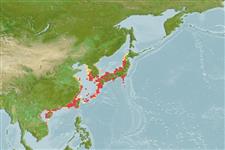>
Gobiiformes (Gobies) >
Oxudercidae (Mudskippers) > Periophthalminae
Etymology: Periophthalmus: Greek, peri = around + Greek, ophthalmos = eye (Ref. 45335).
Issue
Eschmeyer (CofF ver. Sep. 2011: Ref. 88002) recognizes Periophthalmus cantonensis (Osbeck, 1765) as valid on the basis of Cyprinus ccantonensis Osbeck, 1865 after several publications posterior to Murdy (1989: Ref. 5218) but without mentioning the later author that we follow here, The original description must be re-assessed as there is few chances that it is a Gobiidae. See Murdy (1989) for the history of that name.
Environment: milieu / climate zone / depth range / distribution range
Ecologie
marien; zoet water; brak water demersaal; amfidroom (Ref. 46888). Subtropical
Northwest Pacific: Vietnam (Ref. 44416), northward to Korea and southern Japan (Ref. 559).
Lengte bij maturiteit / Grootte / Gewicht / Leeftijd
Maturity: Lm ?, range 4 - ? cm
Max length : 10.0 cm TL mannelijk / geslacht onbekend; (Ref. 5258)
Distinguished by the following characteristics: pelvic fins united anteriorly by a moderate
to strong frenum; medial rays united by a membrane for about half their length; D 1 height moderate, its margin rounded, a dusky stripe inframarginally and no spots on fin, no elongate spines; D2 with single dusky stripe inframarginally; dorsal fins not connected by membrane;
D I with 1O-l7 spines; longitudinal scale count 75-100; head width 14.1-19.8% SL; pelvic fin length 11.5-14.6% SL; length of anal fin base 16.1-22.2% SL; length of D2 base 19.8-24.1 % SL; total D2 elements 12-14; total anal fin elements 11-13; TRDB 19-29 (Ref. 5218).
Facultative air-breathing (Ref. 126274); Intertidal, actively shuttling back and forth between rock pools and air (Ref. 31184). They breathe air when out of water (Ref. 31184). Can stay out of the water for up to 22-60 hours if kept moist (Ref. 51276). Inhabits level mudflats with no vegetation (Ref. 92840). Found in estuaries, swamps, marshy areas and tidal mud flats. Moves around briskly on land preying on small animals. Used in Chinese medicine (Ref. 12166).
Levenscyclus en paargedrag
Maturiteit | Voortplanting | Paaien | Eieren | Fecunditeit | Larven
Murdy, E.O., 1989. A taxonomic revision and cladistic analysis of the oxudercine gobies (Gobiidae: Oxudercinae). Rec. Aust. Mus., Suppl. 11:1-93. (Ref. 5218)
Status op de Rode Lijst van het IUCN (Ref. 130435)
Gevaar voor de mens
Harmless
Gebruik door de mens
Visserij: van geen belang; Aquarium: Commercieel
Meer informatie
ReferentiesAquacultuurAquacultuurprofielKweeklijnenGeneticaElectrophoresesErfelijkheidZiektesVerwerkingNutrientsMassaconversie
Tools
Speciale rapporten
Download XML
Internetbronnen
Estimates based on models
Preferred temperature (Ref.
123201): 16.3 - 26.7, mean 22 °C (based on 280 cells).
Fylogenetische diversiteitsindex (Ref.
82804): PD
50 = 0.5000 [Uniqueness, from 0.5 = low to 2.0 = high].
Bayesian length-weight: a=0.00851 (0.00549 - 0.01319), b=2.98 (2.85 - 3.11), in cm total length, based on LWR estimates for this species & (Sub)family-body (Ref.
93245).
Trofisch niveau (Ref.
69278): 3.2 ±0.4 se; based on size and trophs of closest relatives
Weerstandsvermogen (Ref.
120179): Hoog, minimale populatieverdubbelingstijd minder dan 15 maanden (Preliminary K or Fecundity.).
Fishing Vulnerability (Ref.
59153): Low vulnerability (10 of 100).
